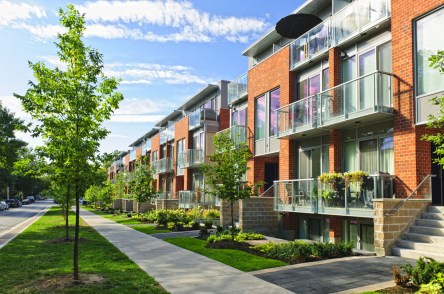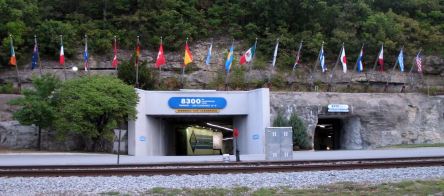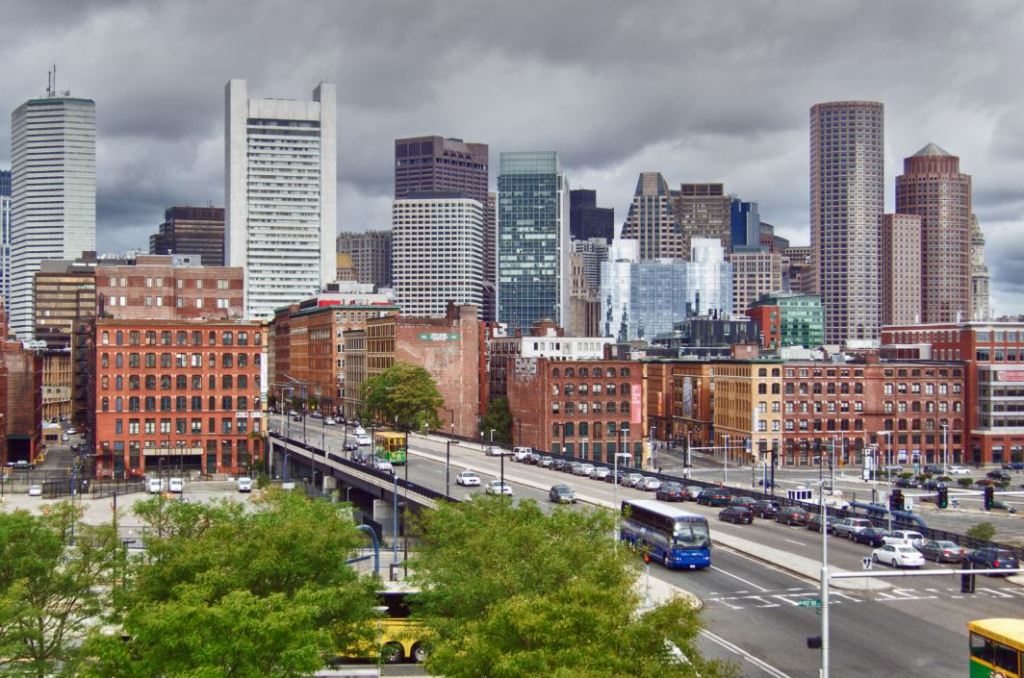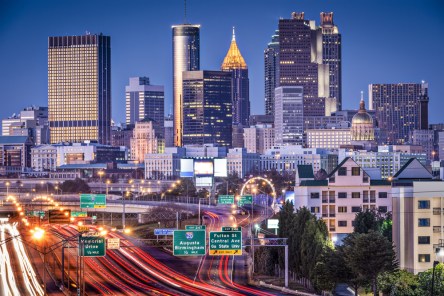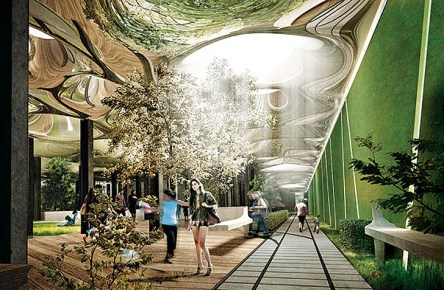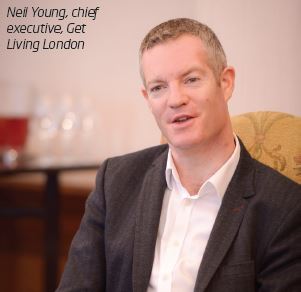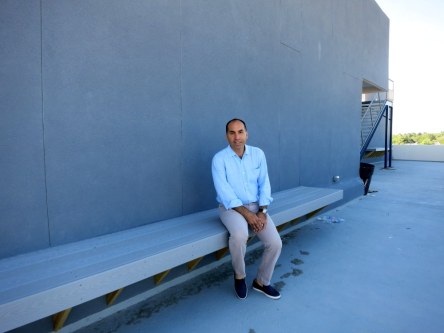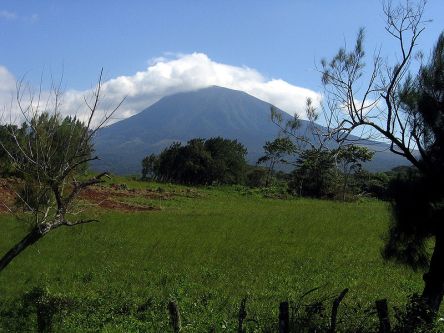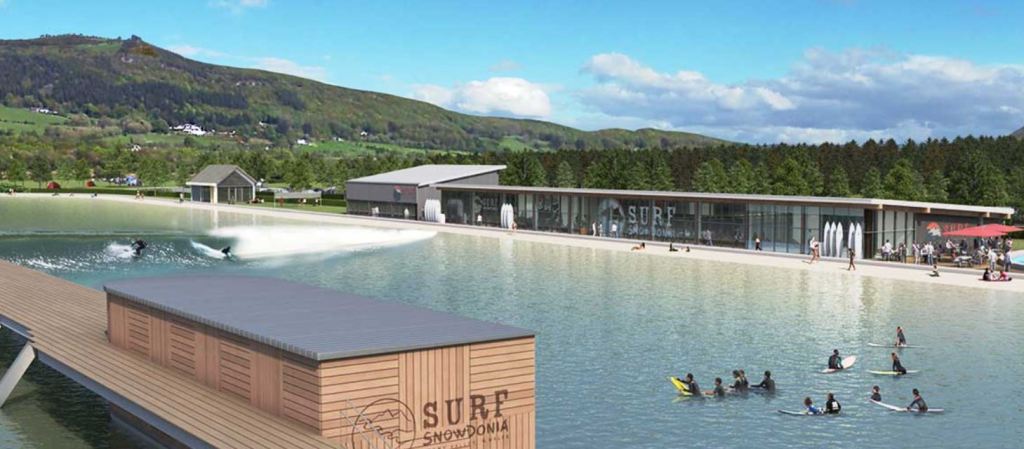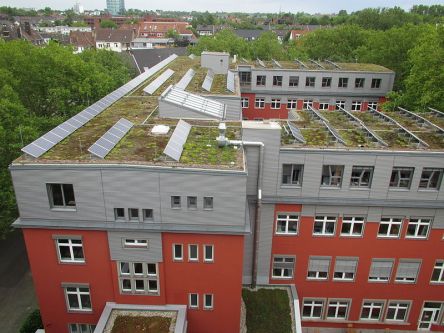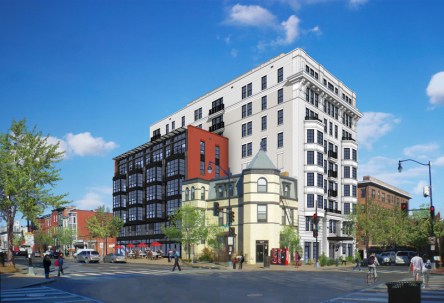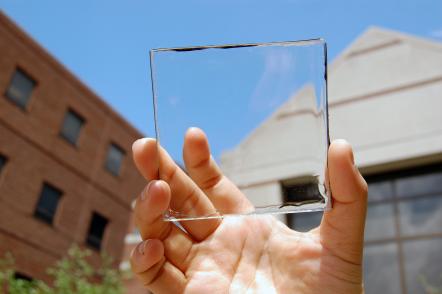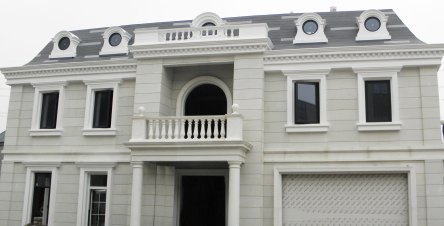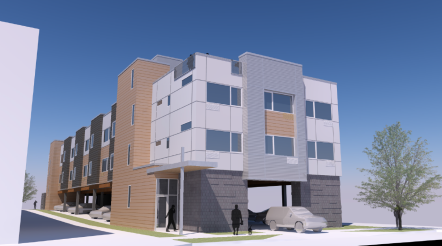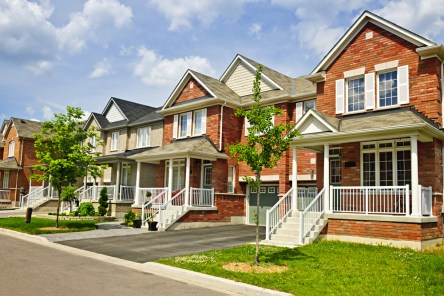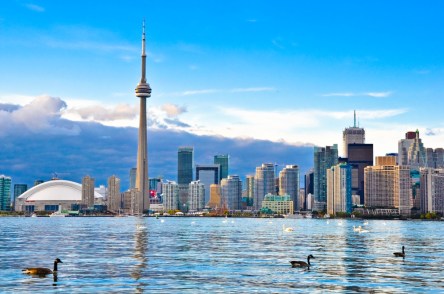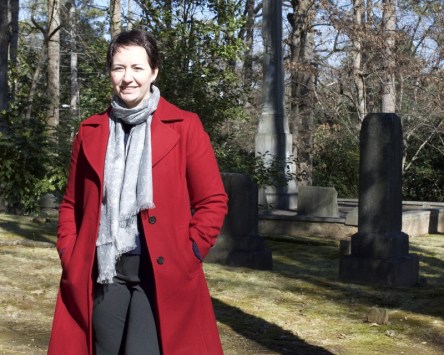Two new recycled brick products offer energy efficient, low-cost solutions for your next green building project. WasteBasedBricks, manufactured by Amsterdam-based StoneCycling, produces bricks by creating a composite of demolition waste, rejected clay, leftover ceramics, insulation, and glass. Clients can chose between machined bricks for large-scale products as well as intriguing handmade bricks for accents and special features. Bricks range from 70 percent to 100 percent recycled product. Each building material is collected within a 150-kilometer radius of the factories that collaborate with StoneCyling.The proximity to manufacturing hubs keeps transportation costs and emissions low. By integrating salvaged building materials, the company is able to reduce the amount of construction waste that is shipped to landfills. “We like to use only secondary materials,” Ward Massa, co-owner of StoneCycling, explained to FastCoexist. “That way it doesn’t end up somewhere in the landfill or being sent to other countries—we reuse it as new raw materials.” StoneCycling keeps production costs low, which allows the company to pass savings on to clients: StoneCycling can also skip clay excavation and processing costs. Manufacturing the product requires less energy than traditional bricks. In Charlotte, North Carolina, Green Leaf Brick raises the bar on green building materials by offering several lines of 100 percent recycled materials. Each product is 100 percent refuse content and as much as 30 percent post consumer waste. Green Leaf Brick, a creation of Red Tree Group, developed the bricks in response to the loads of construction waste heading to American landfills. The company aims to make use of waste streams with little residual commercial use. Brick products include more than 25 recycled raw materials. Different combinations of those materials result in a line of aesthetically stunning bricks and pavers in a wide range of colors and textures. There...
Adaptable Olympics
Nomadic Architecture
While past Olympic Games have left graveyards of unused stadiums in their wake, Brazil hopes its facilities will live on even after the athletes have left the building. Though some aspect of the Rio 2016 Olympics may not be living up to expectations, Rio mayor Eduardo Paes expects many of the locations specifically constructed for the games will outshine past Olympic venues, especially when it comes to longevity. From handball courts to stadiums, the city’s entire Olympic infrastructure exists in flux – designed to transition from its primary function to something entirely new once the games are over. With a heavy emphasis on “nomadic architecture,” several of the Rio’s Olympic settings will be repurposed after they’ve serviced their primary function. The pools, arenas and fields will eventually become schools, parks, community swimming pools and much more. No More White Elephants One of the curses of hosting the Olympics is leftover infrastructure. Few cities are capable of supplying sites for every event, and so pools appear out of empty fields and stadiums rise up along the skyline. Beijing’s Bird’s Nest lives on as a tourist attraction – and occasional soccer spot – but its glory days will never be revisited. In Athens, the Olympic Park lies abandoned, covered in rust and slowing fading in a cloud of neglect. Meanwhile, Sochi’s once bustling Olympic Village now lies empty, inhabited only by stray dogs and unfinished construction. In acknowledgement of the burden placed on host cities to supply appropriate sporting arenas, the International Olympic began to encourage bidders to spend some time planning for life after the games. London, one of the first examples of this legacy mode philosophy, took the suggestion to heart by including several structures that were easily dismantled and repurposed. Many other cities,...
Silence is Golden
Multifamily Soundproofing
One common pain point for renters is noise control. Sharing walls entails a lack of privacy and the potential tension amongst residents. Innovations in building materials are now making units quieter, giving prospects yet another reason to love renting. Road noise (or the horrid violin practice of the kid next door) are no longer deal breakers for your prospective renters. Pennsylvania-based manufacturer CertainTeed has developed SilentFX QuickCut noise-reducing gypsum board. It is emerging as a fast and effective method of noise control within multifamily installations. The product is much easier to install than resilient channel or double layer wallboard. Installation techs can learn the process quickly, a winning feature for any new product. A traditional drywall knife and nails are all that techs need to install the boards. The product can be installed over steel or wood framing, making it a versatile product for residential and mixed used applications. Unlike boards with channels, SilentFX QuickCut will not decouple or short circuit. The integrity remains intact during and after installation. The leads to fewer call backs and complaints to your front office. The ease of installation and durability are attributed to the boards’ composition: two dense gypsum boards are filled with a viscoelastic polymer. The outer layers are covered with a recycled paper product that resists mold and mildew, ultimately contributing to indoor air quality. Fire resistant boards are also available. The gypsum board is designed for construction projects that require a sound transmission class rating of 50 and higher. SilentFX QuickCut smothers a wide range of frequencies, including airborne and impact sounds. For your renters, this mean optimal noise control. Finally, a product that can drown out the squawking of children’s toys, blenders, and the thud of an unsuccessful yoga practice. That alone is...
Green Senior Living
A Sustainable Priority
Though the GenX and Millennial generation are often touted as the “green living” demographic, as the New York Times reports, demand for green retirement communities is on the rise, outstripping supply and inspiring new projects and renovations. Sustainable Retirement Many of the newest senior living facilities include state-of-the-art technologies that are inherently energy and water efficient including low-flow fixtures, LED lighting, and onsite power systems including solar and geothermal. Natural light and an avoidance of toxic building materials helps developers provide living quarters that are aesthetically and philosophically pleasing to potential residents. As a bonus, many environmentally friendly options can also help property managers save money. Increased efficiency can lower energy costs by reducing electricity demands, and there is often government funding available for retrofits and renovations. Another surprising benefit – onsite power systems can also serve as backup during natural disasters or service interruptions, enabling facilities to stay up and running during a grid failure. Leading with LEED When LEED for Health Care was adapted in 2011 to include assisted living communities and nursing homes, many communities seized the chance to earn certification. Because of strict regulations within the health care industry, allowances were made to the certification process and special protocols were included to account for issues like infection control and patient privacy. LEED properties adhere to a comprehensive set of guidelines that cover not just energy use, but construction waste, water efficiency and landscaping, and greenhouse gas emissions. While LEED provides a standard for sustainability, many communities are also finding other ways to expand the notion of sustainable senior living. Even without LEED certification, many facilities prioritize recycling and walkability. Many pledge to avoid pesticides and introduce drought resistant landscaping. Some communities even make a farm-to-fork pledge, buying a majority of foodstuff and...
SubTropolis
Technology goes underground
SubTropolis is the “World’s Largest Underground Business Complex,” developed by Kansas City Chiefs owner and real estate developer Lamar Hunt. The excavated mine, located in Kansas City, Mo., is approximately the size of 140 football fields. The underground city, 160 feet beneath the earth, was created through the mining of a 270-million-year-old limestone deposit which began in the 1940s. It wasn’t until 1960 that the owners realized they had a gigantic area they could rent, sell and lease for business operations. Now, 14 million square feet of the 55 million square-foot cave is an industrial park with illuminated, paved roads and several miles of railroad track. SubTropolis is home to over 50 national, international and local companies in the fields of e-commerce, automotive and storage industry. Approximately 1,700 employees work under the “World’s Largest Green Roof,” with the facility storing everything from postal stamps to the original film reels of Gone With the Wind. Currently more than 6 million square feet is occupied with 8 million more to move into. The eco-friendly underground campus also houses a state-of-the-art data center; SubTropolis Technology Center. STC, an underground data center carved out of 18,000 to 24,000 pounds per square inch solid limestone which is six time stronger than concrete, provides a level of security and strength unmatched by any other traditional data center facility. Armed security, 24x7x365 patrols, monitoring, key card, gated barriers and biometric readers make the technology center an indestructible and impenetrable fortress. STC also has a six-acre equipment yard on the exterior surface for future infrastructure. SubTropolis Technology Center has the advantage of space, with millions of square feet available for IT and raised floor area. The facility provides customers with data center suites ranging from 5,000 square feet to 100,000 square feet,...
Neighborhood Transformed
Boston’s new Green District
Extravagance and environmentalism don’t seem like natural soulmates, but in Boston a new set of developments seamlessly combines the amenities and modern sensibilities of today’s luxury living with eco-conscious construction. The result? Affordable, eco-conscious community housing for Boston’s middle class that’s been dubbed the “Green District.” The brainchild of developer Bruce Percelay, the “Green District” sits at the intersection of Brainerd Road and Redford Street in an area of Boston commonly known as Allston. Conceived as an enormous 500-units housing project with an initial cost of $125 million, the Green District consists of six buildings – The Element, The EDGE, Eco, The Metro, The Matrix, and The Gateway – designed for sustainable living. The Green District began to take shape in 2012, just after the real estate market crashed and most developers were playing it safe. “I bet the farm,” Percelay admits in an interview with the Boston Globe, but the wager paid off – the three new buildings were sold to the National Development of Newton for $150mil in 2014, with Percelay initially managing the properties. National Development took over the administration of three Green District buildings – the Element, Edge and Eco – earlier this year. Residents moving into Green District flats will be privy to a slew of environmentally friendly features, from recycled materials to energy and water efficient fixtures and appliances. Outfitted with solar panels, low-flow fixtures, and other green amenities, the Eco, Edge and Element are all LEED certified and priced 30-50% below the city’s high-end developments. Though the rents are lower than most high-end rentals, the amenities are on par with what you’d expect at the most luxurious apartments: gym, rooftop decks, a movie lounge, pet-grooming stations and even a putting green. Priced in a range that starts at $1,700 for a studio and hits a high of a little over $3000 for a 2bedroom/2bath apartment, Green District rents are about on par with Boston’s average rent of $2200-2700 for similarly sized living spaces. The development is also designed to foster a sense of community among its inhabitants, encouraging resident brunches, and offering free yoga classes. Renters can also partake of on-site dry cleaning pick-up, bike storage, and easy access to Boston’s mass transit. “We love our unit,” declares one Yelp reviewer of The Edge, “gorgeous floor to ceiling windows with custom blinds, very nice layouts and fixtures, and a sharp modern look. Nothing feels cheap or Ikea-esque. Definitely the closest to having a “home” that I’ve come to in my years of renting.” “Management has been pretty great and very, very responsive,” adds another Yelper, “they get back to you immediately and repairs are made ASAP (same day or next morning). They seem to genuinely care that you are happy with your unit and the building.” Despite the all the extras and bonus activities, the development’s commitment to the environment is readily apparent. Denizens of the ECO, the Green District’s platinum LEED homage to European design apartments, must sign a “Green Declaration” as part of their lease, stating that they are committed to energy and water efficiency, along with recycling, alternative transportation, and “other eco-conscious practices.” From inception, one thing was clear: sustainability sells. The project’s first building, the Element, opened on July 1, 2012, with 70 percent of the 100 units already rented. “The most environmentally sensitive building in the country won’t work if the tenants won’t work with it,” Percelay told the Boston Globe back in 2012. “You want tenants who understand the philosophy. Our belief is that by creating the awareness, you attract tenants who care.” “We were in the unusual situation where we controlled a neighborhood,” he elaborated. “We wanted to do something different, set a new standard. The green movement is here to...
Breaking Records
Atlanta Offices 2016
It’s the perfect combination: a boost in local jobs, diminishing office supply, and rising rents. The three have positioned the Atlanta office market for a record-breaking year. With a conservative lens, JLL lists the Atlanta office space vacancy rating at 17.5 percent and average rents of $22.54 per square foot. Transwestern confidently states a 15.9 percent vacancy rate and average rates closer to $25. In both scenarios, this quarter marks one of the highest asking rents in nearly 30 years. There is still room to grow. Conditions suggest that asking rents could approach $30 per square foot: PM Realty Group estimates that Atlanta broke its 2000 occupancy gain record. The market totaled almost 3.7 million square feet of office space absorption for 2015. The resulting 14.2 percent vacancy rate for Class A properties broke a 15-year low, according to Transwestern. Atlanta’s Class A direct occupancy rates broke a 14-year record, increasing by 300 basis points to 86.7% over the prior 12 months. Class B office space accounted for 29.7% of the total net absorption for 2015. Just three years ago, Class B office product saw negative absorption in Atlanta. Demand for quality office space in Atlanta continues to grow. BisNow reports that Metro Atlanta is expected to add 60,000 jobs per year for the next few years. Nearly 25 percent will be “premium” jobs that require office space—yet only 885,000 square feet of office space is under construction for the year. If 885,000 square feet doesn’t sound like a game-changing amount of space to you, you’re not alone. It’s barely a drop in the preverbal bucket. With the exception of residential, many investors still see real estate as a risky investment. Funding for new construction remains scarce, which means that existing Class A properties...
Under Delancey Street...
New York's Lowline Project
A new era of metropolitan re-use and restoration is taking hold in cities around the world. On New York’s Lower East Side, two visionaries are taking the urban greenspace movement to the next level by putting it underground. With a planned debut in 2020, the LowLine project promises to create a calm, cultivated woodland atmosphere in an abandoned trolley terminal sprawled out beneath Delancey Street. Buried in New York’s Lower East Side lives a secret space and futuristic opportunity. In 1908, the Williamsburg Bridge Trolley Terminal debuted. The one-acre property located under Delancey Street primarily served trolley passengers traversing Manhattan’s submerged passageways. Though it’s been shuttered for more than 60 years, the original vaulted ceilings and cobblestone walkways still sit, patiently waiting for a new era of city residents to venture below. If James Ramsey and Daniel Barasch have their way, those Big Apple visitors will soon be enjoying a belowground wonderland, outfitted with hidden nooks, man-made stalagmites, trees and maybe even a hitchhiking frog or two all lit-up by the latest in solar-refraction technology. Christened the LowLine, this subterranean greenspace is part botanical garden, part laboratory, and part social experiment. For co-founders Ramsey and Barasch, the LowLine offers the chance to add much-needed greenery to one of the city’s most urban environments. A Shared Vision Manhattan’s Lower East Side represents a microcosm the borough’s transformation from humble, insular neighborhood into a jubilant melting pot of immigrants, boutique businesses, corporate high-rises and creative visionaries. When Ramsey learned of the Williamsburg trolley terminal in 2008, he was struck by its potential. He envisioned plants and trees thriving in a sort of “park” that would benefit the entire community. “It’s not every day that you find 60,000 square feet in New York, right?” Ramsey recently stated...
Yardi Think Tank
London's apartment market
LONDON – The burgeoning demand for rental property – particularly in London – means developers of build-to-rent schemes have a captive market, but everything else from valuation to finance and planning seems to be stacked against the sector significantly expanding. What do the pioneers of this form of development have to tell us about the state of the UK housing market and housing policy, and how are they overcoming the odds to deliver profitable schemes? Panel participants: Claer Barrett, Financial Times – Chair Dominic Martin, Operations & Strategy –Westrock Neil Young, Chief Executive – Get Living London Ryan Prince, Chief Executive and Co-Founder– Realstar Living James Scott, Chief Operating Officer –The Collective CB: There has been a lot of noise about ‘build to rent’ as a policy, but correspondingly little development in the private rented sector (PRS). Why is it so challenging financially? RP: It is uneconomic for PRS developers to compete with housebuilders. By our estimates, they can pay 30% more for a site. Then there is the time it takes persuading the planners. When you actually do the math, taking planning, construction, leasing risk and time into account, returns can actually be pretty poor. Most new PRS schemes are either government-procured PRS, where land is marketed on the basis that it will be PRS instead of homes for sale, or part of large-scale regeneration projects. If you remove those specific circumstances, you have no real meaningful, scalable policy framework to have a PRS industry in the UK. I think it gets disproportionate headlines relative to its size. DM: We still do not have clarity for PRS in the planning process. The London mayor’s supplementary planning document is starting to go in our direction, but it is still only guidance. Local authorities can do...
Modular Multifamily
Time + Cost Efficiency
Modular single-family homes are old news in the United States. Modular multifamily, however, is just catching on. American multifamily firms are experimenting with modular apartments—and they love the results. Residential modular construction in the US has increased by 32.8 percent since 2007 according to the Modular Building Institute. The boost in projects comes as builders begin to realize the benefits of off-site construction. Benefits include: shorter cycle time since units are built in a controlled environment with fewer unexpected delays and setbacks improved energy efficiency minimal-to-zero material cost overrun lower labor costs consistent finished products Tricorp Hearn Construction of Sacramento experienced these benefits firsthand with its most recent multifamily project. Tricorp chose a modular construction plan for its Eviva Midtown complex. The finished product will be six stories high, including 118 units, each at 12 x 64 feet and weighing 35,000 lbs. The pre-fabricated units will rest atop 5,000 square feet of retail space and an underground parking garage. The project is slated for completion in spring 2016. Total production time for the modular complex is just 18 months. That’s notable savings over the 24-month estimate used for conventional construction. So far, the project is on schedule, on budget, and already piquing the interest of apartment seekers. Modular construction does have its disadvantages. Disadvantages include: increased lead time as much as 150% more resource usage, since units do not share walls, floors, or ceilings high product transportation costs lack of skilled labor, as few architects and contractors have experience with large-scale modular projects and fewer laborers know how to combine units For most developers, the benefits outweigh the disadvantages. Since modular buildings have faster cycle times, they can begin earning rents faster. This can result in greater profits than their site-constructed counterparts. Equity Residential’s...
New Mexico Rising
Albuquerque's real estate trends
ALBUQUERQUE, NM – The Platinum is not your typical Albuquerque apartment complex. It is four stories, expected to be LEED-Platinum certified, with city and mountain views: in other words, a modern marvel that will draw some of the city’s highest rents. It’s surrounded by Nob Hill, Albuquerque’s most walkable urban neighborhood. The area is a mix of higher education, restaurants and service businesses along Central Ave., also known as historic Route 66. “This is Albuquerque’s main street,” says Rick Goldman, developer of The Platinum and two other nearby condo and loft projects. “Usually, retail follows rooftops. But in this town, you had retail on Central, but no rooftops to speak of.” Albuquerque has sprawling single family housing tracts spread across the city. High density apartments rising above two stories tall are rare. Your typical Albuquerque apartment complex, says longtime broker Todd Clark, “was built in 1970, is two-story, brick, with a pitched roof, master-metered and originally offered furnished. It’s an island surrounded by a sea of parking.” So is the Platinum a symbol of things to come in New Mexico? Maybe. But there are challenges ahead before Albuquerque can be considered a transit-friendly, walkable urban destination. Breweries and buses How can you tell when a city is poised for an influx of millennials? CBRE’s Billy Eagle, who specializes in multifamily sales, suggests that you might want to track brewery openings. “During the last two or three years we’ve seen the breweries expand five-fold. I think there are now more than 25 in town,” says Eagle, who relocated to Albuquerque from Southern California eight years ago, when he was in his early 20’s. He talks enthusiastically about cycling around downtown, weekly farmer’s markets, new restaurant openings and Uber: all hot with Millennials. During his time...
Renewable Future
Race to Carbon Neutrality
The United Nations predicts that by spring 2024 the world’s population will reach 8 billion. Meeting the energy needs of the world’s ever-growing population is a hot-button issue, especially in the context of finite carbon-based energy sources and the looming danger of irreversible climate change. While going carbon-neutral can seem like an unachievable goal in its complexity, there are trailblazers whose goals are exactly that: shifting populated environments away from fossil fuel dependency and onto a system of renewable energies. We’ll be taking a look at some the superstars of carbon-neutral environments and renewable energy trailblazers. Costa Rica The 2010 winner of the World Future Council’s Future Policy Award, Costa Rica has long been lauded for its environmental conservation and protection initiatives. But the little Latin American country was the focus of intense global acclaim in March 2015 when it announced that it has generated 100 percent of all its electricity from renewable sources for the 75 days straight of the year. The state-run Costa Rican Electricity Council (ICE) released information detailing that it had managed to avoid using any fossil fuels to generate electricity until mid-March by using a combination of biomass, wind, solar, geothermal and most importantly hydroelectric power plants, boosted by heavy rainfall experienced this year. Under normal conditions, Costa Rica already sources 88 percent of its electricity from renewable sources. Hydroelectric plants provide 68 percent of Costa Rica’s electricity followed by geothermal plants with a 15 percent share, wind farms provide 5 percent, biomass sources under one percent and solar chips in with 0.1 percent. Carbon-zero 2021 The Central American country plans to further expand its renewable power plant infrastructure in a bid to achieve carbon neutrality by 2021, as pledged six years ago. 100 megawatts worth of wind warms...
Parking ROI
Creative Parking Solutions
For most of us, parking is little more than a necessary evil. If we could, we’d use the parking space for more units and enjoy the additional cash flow. But what if your parking lot could become an asset? From practical to extravagant, these creative parking solutions can transform a requirement into a revenue-generating tool. Creative Parking In metropolitan areas, the ability to offer multiple parking spaces per household may give you an advantage over the competition. Get the most out of your available space by ditching the traditional parking scheme for one that is growing in popularity in the UK. The layout above permits narrower rows thus potentially more rows for your site. Automated Parking Urban luxury properties may consider electronic self-parking. The featured automated parking tower above is for a Volkswagen plant but add in a “valet” for the electronic system and you’ve tapped into a marketing feature. (Robotic Carpark in Dubai shows a non-commercial application.) It only takes 15 seconds to park or retrieve a vehicle. While the space savings is significant and the amount of parking you can offer tenants is appealing, the bragging rights may be a tower’s greatest appeal. Commuter Options Shuttle may be an excellent asset for suburban rental communities. When you can’t offer residents direct access to public transit, a shuttle to and from the nearest station can be even better. Residents gain access to affordable transportation into the city without concern for weather conditions, paid parking at the station, or parking security. Before implementing a plan, a quick survey from the community may help you determine the cost structure and travel times that will be most successful. Added Amenities Adding amenities to parking areas is another way to generate revenue. Traditionally, this has...
Making Waves
Man Made Surf Comes Austin's Way
Until recently, surfing has been an activity limited to the lucky ones with oceanfront access. This is about to change with some incredible technology created by Spanish engineering firm Wavegarden, which has the capability to deliver the longest man-made surfable waves on Earth. Sounds surreal, doesn’t it? Doug Coors, a descendent of the Coors Brewing family, made it his mission to put Austin, Texas on the surfer’s map by bringing the ocean-bound sport inland. The self-proclaimed engineer and surfer, founder and CEO of NLand Surf Park, LLC said it took him 15 years to find the proper technology to mimic an actual surf break. He found it in Spain and decided to bring it to North America. Coors plans to raise these waves for the public starting next year. Why Austin? Austin has become a powerful magnet for investors and tourists, a weekend heaven for festivals and activities of all kinds – from SXSW to triathlons for the disabled, biker rallies, and Eeyore’s Birthday Party. Sports lovers and creative entrepreneurs have made Austin their home partly due to the willingness to give new ventures a chance, no matter how ambitious they are. Probably the best example to sustain this perspective is the recently completed Circuit of The Americas Formula 1 track, the first in the country to be built specifically for F1 races. Interesting is that it is located down the road from the proposed NLand Surf Park site. The lagoon will be located east of Austin-Bergstrom International Airport on rural property as big as nine football fields. The complex will offer 11 different surfing areas, with four different surfing levels, designed to create every 60 seconds perfect waves ranging between one to six feet high, with a surfing experience of 35 seconds per wave; think 300 distinct waves per hour. The technology behind the massive lagoon has been created in collaboration with the team and tech at Wavegarden in Spain, who proved its capabilities through the thousands of waves it has pumped in the Basque Country wave park. One of the most intriguing and fascinating facts about NLand Surf Park is the claim that, after the initial fill, the park will be self-sustaining with rainwater, even during tough drought conditions. Imagine surfing on raindrops. “Our top priority is water and water conservation,” Coors told Think Progress. “The surf community is very environmentally conscientious and they pride themselves on environmental stewardship. We want to fit in with that as much as possible.” With the water consumption solved, energy use comes next. Water is heavy and moving it needs energy; the ocean has the sun and the wind to create the waves, how will this massive project be fueled? Even though Wavegarden’s CEO Josema Odriozola said that the energy consumption in the company’s technology is much lower compared with the other existing wave generation technologies, the matter is a hot subject. One solution would be to make the park use solar power by placing panels on the unused land; however, this part of the project has not been nailed down yet. Coors has been discussing with three solar providers to determine the possibilities. Austin-based White Construction Company was chosen to execute the project within eight months with approximately 90 construction craftsmen and professionals on site. The undertaking is privately funded. Backing for the project is provided by 9th Street Capital, a Colorado-based private equity firm where Coors is president. Opinions on the project are diverse, ranging from excitement to anger, but the project will happen. NLand Surf Park will be just like an indoor rock climbing gyms – perfect for training. Sounds like it will be a destination for all the surfers who have relocated in Austin, until they make it back to Mother Nature’s...
Glorious Green Roofs
Renewable Future
France, the epicenter of style and fashion, has recently dealt a blow to the detractors of solar panels and green roofs by passing legislation that will require all new commercial buildings to feature green roofs. New buildings constructed in French commercial zones will have to be partially covered by either living foliage or solar panels, under the new law, which, albeit less drastic than its initial form (which would have applied to all buildings and the entire surface of roofs), will have a significant impact. Installing solar panels will obviously add green energy to France’s massive energy appetite. Green roofs will bring their own plethora of environmentally friendly features. Higher costs –bigger returns Green roofs significantly increase the insulation of a structure, thus decreasing the need for air conditioning and heating. According to a recent study by Universidad Politécnica de Madrid and Università Politecnica delle Marche researchers, roofs with dense vegetation are 60 percent more efficient than traditional roofs and can in fact act as passive cooling systems. Furthermore green roofs absorb less heat during the day than traditional roofs, thus lowering the heat island effect that plagues cities, especially large urban environments. This is further exacerbated by the fact that green roofs release less energy during the night than they absorb during the day. Moreover, green roofs absorb a large quantity of rainwater, reducing runoff, decreasing the pressure put on city sewage systems, especially during large weather events. When local and/or drought-resistant flora is used for green roofs, there is little to no added water consumption. Green roofs also contribute to healthier environments by absorbing pollutants and releasing oxygen and providing shelter and nesting places for birds and small local fauna, contributing to local biodiversity. Green roofs can also be used as gardens...
UK Asset Management
Recovery + Reinvention
Asset Management companies in the UK have experienced several years of growth due to foreign capital flowing into the country during the lean years. As rents stabilize, the rate of growth is clearly unsustainable. Yardi brought together several asset management experts to discuss how asset management will reinvent itself during economic recovery and prosperity. According to Richard Williams, managing director asset services UK, CBRE , The answer boils down to the company’s country of origin. Far Eastern and Middle Eastern investors continually require traditional asset management services. “That’s where most of our team’s work has come from in the last year. Although they tend to buy trophy properties, we spend a lot of time teaching them the fundamentals of asset management. It’s impossible for them to do this from Asia where they’re based.” Locally, there is a different story. Shaun Hose, director of asset management, BNP Paribas Real Estate, explains, “Now, the market has improved to such an extent that the yield shift alone won’t meet target returns. Institutional investors are looking for assets they can intensively manage and have levers to pull. The regions are high up on the agenda for UK investors as occupier markets come back, but London markets continue to be dominated by foreign investors.” This leaves local investors seeking a select few assets that will offer the value that they need: core plus assets with both income and an angle, and doughnut assets that are inside the M25, but outside of central London. Such properties include multi-let industrial, or distribution centres, with their low vacancy rates, resilience, and growing popularity. Such centres are often occupied by online retailers, powerhouses whose bravado is far from diminishing. There is also a notable amount of obsolete properties that could use a second wind....
Resmark’s 10Eleven...
Modern Classic in Metro DC
Yardi client The Resmark Companies has teamed with Streetscape Partners LLC and Community Three Development LLC to develop 10Eleven, a 71-unit condominium and 4,257 square feet of ground-level retail space, in the historic Logan Circle area of Washington, D.C. “The project, dubbed 10Eleven, will appeal to professionals seeking a high quality, newly built urban residence that offers a walkable lifestyle with excellent access to public transportation, employment, amenities and services,” Alexandra Johns, Resmark’s senior vice president investments, told MHN. “In addition, the project will include retail and restaurant space on the ground floor to offer homeowners and neighbors even more options for everyday convenience and onsite leisure.” Located at 1011 M St., 10Eleven will appear to be two distinct buildings, inspired by the rowhouses and classic apartment buildings in the neighborhood, and suggesting the attention to detail carried throughout. The 71 condominiums will include one- and two-bedroom floor plans and luxury penthouse units. The roof deck, reception lobby and corridors will feature a sophisticated level of finish with design by Darryl Carter, a noted D.C. tastemaker, author and boutique home design retailer. Chief among the amenities is a roof deck with grill, fireplace, trellis and furnishings that will offer views of the skyline and space for outdoor relaxation and entertainment. The property’s location, at the intersection of 11th and M Streets, NW neighbors other new residential developments as well as classic townhomes and smaller commercial buildings on tree lined, pedestrian friendly streets. “Logan Circle is a historic area of the District that melds modern developments with classic Victorian heritage,” Johns said. “The neighborhood is eminently walkable—just two blocks north of the Central Business District and surrounded by four Metro stations. And Logan Circle is known for its variety of retailers, restaurants, art galleries, live...
Excellence Awards
Nominations are Open
MHN Excellence Awards recognize the multifamily industry’s most noteworthy people, companies and properties. The 2015 winners will be selected by a panel of judges representing expertise across all multifamily disciplines. Submissions will be due by Monday, June 15. Here’s how to enter. 1) Select the categories you’d like to enter and click to download those entry forms for rules and instructions; • Executive of the Year • Property Manager of the Year • Leasing Agent of the Year • Development Company of the Year • Property Management Company of the Year • Best Brokerage Office • Transaction of the Year • Best Apartment Community • Most Tech-Savvy Community • Best Marketing Program • Best Value-Add Renovation • Best New Development and Design • Best New Development: Unbuilt 2) After completing the entry form(s), click here to upload form and submit payment online. (You still have the option of mailing us your entry as hard copy in a binder and/or paying by check; follow those instructions after you download the entry form from the list above.) If you have questions, contact Diana Mosher, Editorial Director at [email protected]. Finalists will be announced in August at multi-housingnews.com and winners will be announced in September at a special event in New York and published in the October issue of the magazine. All winners will receive a personalized award for display in their office or multifamily...
Bright Future
Harnessing solar technology
With the effects of climate change becoming more and more visible every passing day, introducing environmentally friendly practices into everyday life becomes increasingly important. And while renewable energy still has high investment costs in many cases, returns on initial investments do not fail to appear. They may come in special tax rates, increase in prestige, lower operating costs, increased rent rates and high occupancy levels, thanks to green-loving Millennials. Plummeting costs And as more research goes into green energy and renewable sources, initial investment costs are dropping by the day. In fact, according to recently revealed research by the Lappeenranta University of Technology (LUT) in Finland, solar and wind energy is expected to become the cheapest form of energy in the near future. The Neo-Energy project, which conducted the research, uncovered that North-East Asia, especially China will be able to switch to a completely renewable energy system within five to ten years, under economically feasible conditions. In fact, project simulations show that the price of solar electricity will be cut in half by 2025-2030, thanks to costs decreasing 20 percent every times capacity is doubled. Solar cells from the sea Not only is solar energy becoming more cost-effective, it is also getting greener every day. While green energy becoming greener does sound somewhat unnecessary, no energy source is completely green. Wind turbines and photovoltaic panels are still manufactured using man-made materials, the production of which does in itself also carry a carbon footprint. Not for long, though, if researchers at Queen Mary University of London’s (QMUL) School of Engineering have their way. In February 2015, QMUL researchers have announced successfully creating electricity-generating solar cells using the chemicals chitin and chitosan, found in the shells of shrimp and various other crustaceans. The two biomass-derived materials...
3D Printed Apartments...
A reality in China
Gutenberg invented the printing press in 1439; since then the printing industry has evolved, from printing blocks to 2D printers with the capacity of mass-producing documents in just minutes. Today, 3D printers are capable of creating pretty much anything, from mechanical parts to prosthetics to buildings. Even though it’s been 32 years since an engineer named Chuck Hull invented 3D printing, only recently the process became one of the industries of the moment for investors. From 2011 to the present day 3D printing has raised almost $4 billion, while during 1987-2010 (23 years) it raised only $300 million. Increase in interest by public investors translates into extraordinary potential and profit in the industry. 3D printing advocates say the technology will be routinely used to build homes, food, and human tissue and believe that it has the potential to revolutionize how we do everything. A good example is General Electric, which announced that it is using this technology to make the next generation LEAP airline engine that will save fuel consumption and expense. Probably the even better news is that 3D printing is no longer reserved for corporations only, but available to all. A Chinese construction firm, WinSun Decoration Design Engineering, unveiled a five-story apartment building, dubbed “the world’s tallest 3D-printed building,” along with a 11,840-square-foot neoclassical mansion, both made entirely with a giant 3D printer. The properties were built with a patented ink created from a combination of recycled construction waste. This project follows last year’s revolutionary initiative when the company built 10 affordable houses in 24 hours, each of 650 square feet at around $4,800. For the affordable project the company used four 3D printers that measure 20 feet in height, 33 feet in width, and 132 feet in length. The process is...
Introducing iUnit
Modular + Energy Smart
Believe it or not, iUnit is not the next device a certain ubiquitous technology company wants you to run out and buy. Rather, it’s a new modular housing project coming to Denver, Colo. in 2015, blending smart energy use, wireless connectivity, green construction and the urban living preferences of American Millennials. iUnit is intended to challenge the way we think about apartment living today, says founder Brice Leconte. A Washington, D.C. entrepreneur with a passion for startup technology, Leconte is currently an Entrepreneur in Residence at the University of Maryland as well as an advisor and mentor at Georgetown University. “iUnit is really a reflection of how I see the world and what I want to do with commercial real estate,” said Leconte, who worked on large single-family home developments early in his career. iUnit at Highland Park is his first foray into the multi-family space. We recently spoke to him about the project and what makes it unique. Tell us about iUnit. What’s it all about? Leconte: There are a lot of things in real estate that don’t make sense to me. One of them is on the modular front – why we are still building buildings out in the elements, while they are being rained and snowed on. I’ve wanted to build differently for a long time, and modular construction has always made sense to me. Building in a controlled environment, we end up with a much better, greener product, and better worker safety. That’s the method we’ve chosen for our multi-family building. We will use a factory in Idaho for the module construction. The other thing that has never made sense to me has how commercial real estate has lagged behind in integrating technology into its buildings. How can we introduce...
Townhouse Trends
New Competition for Rentals
National multifamily rents are no longer skyrocketing at breathtaking rates. The news could cause renters to send thank you letters to the powers that be, if they knew who or what those powers were. Primarily, renters can thank a boost in multifamily development which is helping to balance supply and demand. Secondly, they can thank the competition posed by the single-family housing market. A growing demand for townhomes has increased the properties’ market share in sales. According to REALTOR.org, existing single-family home sales are up by 5.2 percent and distressed property inventory has decreased by 23 percent compared to this time last year. The recent stats demonstrate that homeownership is now more accessible for many, particularly when it comes to existing properties. New construction is also becoming more accessible. Total single-family attached construction was up 17 percent on a year-over-year basis by the fourth quarter of 2014, census data reports. Townhouses may soon constitute 11 percent of all single-family developments, inching slowly towards the most recent high of 14.6 percent of market shares last seen in early 2008. The total market share of townhouses is expected to continue its gradual rise in years to come. When looking at market trends, the growth of townhouse sales makes sense. Townhouses offer an ideal compromise between features that both Millennials and Boomers crave in rentals and single-family properties: -Townhomes fit well into urban environments, where so many Millennials and Boomers have set their sights. Single-family attached properties work well in metropolitan infill lots that are on the smallish side for apartment complexes yet are too profitable for one single-family home. -Townhouses come with less yard space than a traditional house, minimizing the amount of time and money that owners must dedicate to maintenance. -Pet owners appreciate that yard space...
Toronto
North America’s Greenest City
Toronto shines as North America’s greenest city according to the Sustainable Cities Index, coming in at a respectable 12th place out of 50 cities. It is the only Canadian city to make the list. European and Asian cities continue to dominate the top rankings each year but Toronto is poised for greater gains. The Arcadis Sustainable Cities Index analyzes 20 metrics in areas such as environmental impact, quality of life, and economic performance. Toronto placed 9th in environmental impact, 15th in quality of life and 18th in profits. A looming population boom may serve as the perfect motivation to improve the country’s environmental impact rating. Within the next 15 years, Toronto’s population is estimated to grow by 25 percent. Infrastructure is developing to meet the needs of the growing population: Ontario earmarked $130 billion over the next decade for new transit, roads, bridges, and similar projects. As part of this plan, GO bus and train lines are expanding services to James North, Stoney Creek, Hamilton, Georgetown South, Kitchener, Unionville and Agincourt. The Scarborough subway will bring additional services to the north by the end of summer 2016. Those improvements are only the first frontier. Premiere Wynne presented a challenge earlier this year for all levels of government to increase investment from 3-3.5 percent to 5 per cent of the nation’s $2 trillion gross domestic product (GDP). The bump in funding will be dedicated to infrastructure renewal each year. But even with adequate infrastructure to meet the needs of residents and visitors, one of the greatest challenges will be supplying the population with sustainable energy. The city currently has about 60 renewable energy installations. (That quantity is small scale compared to other cities of its size, though it’s better than other cities in North America.) The new hydro-powered Copeland Transformer...
Bettering Buckhead
A community in transformation
It’s never too late to improve livability. Buckhead, an affluent and well-developed Atlanta submarket, demonstrates that notable change can be made even in established areas. Green space and cultural engagement are key to the transitioning community’s success. Markets experiencing the strongest, most sustainable growth these days are those where residents can work, live, and play in pedestrian-friendly communities. Ownership of a single-family home, an automobile, and long commutes from the suburbs don’t rank high on Millennials’ lists. Instead, they trend towards pedestrian neighborhoods with alternative transportation, active street scenes, and an emphasis on environmental stewardship. Buckhead fell woefully short in many of these areas. The submarket gained a reputation throughout metro Atlanta for its sprawling estates and commercial success but it was decidedly unapproachable and in many potential residents’ eyes, unlivable. Without major changes, Buckhead would sabotage its own growth and vitality. One spark initiated the necessary changes. In 2011, Denise Starling received a daunting task. The Executive Director at Livable Buckhead found herself facing a green space deficit and a demand for change. “Howard Shook is our councilman and he came to us and said ‘City of Atlanta just did this plan that identified my district as the lowest parked in the entire city of Atlanta. That can’t be. Go fix it!’ He literally said, ‘Go fix it!’” Starling laughs. “We’re like…alright. So that’s basically how we started a green space plan.” The councilman was right. At the time, the Community Improvement District, Buckhead’s commercial center, had only 2.14 acres of green space per thousand people. The standard is 15 acres. Establishing parks became the organization’s primary objective. Walkability was also a sought-after feature that Buckhead lacked. At the time, WalkScore dubbed the area as “car dependent,” entailing that most residents had to...
Build Smarter
Or it's free
Building a house is nothing like ordering a pizza over the phone. But maybe it should be. With few exceptions, restaurants order ingredients and supplies in advance. They create a menu of offerings and then take orders over the phone based on the menu listings. Substitutions are made when the order is placed. Once the staff ensures that they have what’s needed, the order is filled. What if contractors took the same approach? It has happened before with a high success rate. Rosie Romero offered “the impossible promise” that projects would come in on time and on budget, or they would be free. Jeb Breithaupt of JEB Design/Build in Shreveport, La. reports to Builder Online that he’s making a similar offer to his clients. Both offer the promise by mimicking the pizza process. The design/build firms spec out the project, like creating a menu and pricing. Clients then make selections and customizations as needed. Once the availability of materials is verified, the orders are placed. Homeowners view and approve the orders and then ground breaks on the project. Clients can’t go back and make changes to the order. The contractors aren’t surprised by changes in price or the availability of materials after the fact. It’s all arranged before the first shovel juts into the ground. This process makes so much sense. “That’s what my company tries to do on custom home projects. I’ve also tried it on a couple of design/build jobs, and believe it or not, it’s making our process smoother and our clients happier,” says Breithaupt. The pizza process has notable benefits. It saves time: No more waiting for materials to arrive or delaying progress because of scheduling problems with subcontractors. Everything is available when and where you need it because it...

